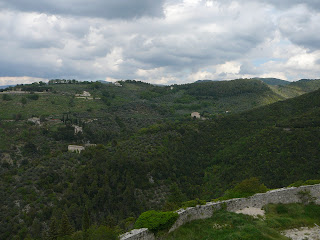Rocca Albornoziana
The Fortress which stands high above Spoleto was built in the 14th century. It was commissioned in 1360 by Pope Innocence VI. Access to the Fortress is either by an uphill path from the town or the easier moving walkway (about 500m of escalators) and a lift. Because our apartment is near the top of the hill we walked through the town to the lift then rode up to the Fortress. Once out of the lift we walked around the Fortress walls to the entrance. Entry fees were 7.50 euros and 6.00 euros (seniors price). Entry is through Pope Eugenio IV's room which is now a reception area and bookshop.

The Rocca Albornozania has had a mixed history. It was built as a strategic fortress to win back previously lost papal territories. It was also the residential seat of the Castellan and the Governor of the Duchy until the end of the 18th century when the Governors moved into the town. In the Renaissance the Rocca was both a centre of Papal power and a luxurious court. Many famous and infamous characters lived there, including Lucrezia Borgia and her brother Cesare (the illegitimate children of Pope AlexanderVI). In 1817 the fortress became a penal settlement and then became a high security prison following the unification of Italy. All of these activities have left their marks as new sections were added to the original buildings. In essence the building consists of 2 large courtyards with six towers and it is situated on Sant' Elia hill. In the 1980s restoration of the building began and the National Museum of the Duchy of Spoleto was opened there in 2007.

 The two large courtyards are the Ward of Arms, which was used for military activities, and the Ward of Honour, which was used by the courtiers. The Ward of Arms is a large parade ground with rooms built into the walls.
The two large courtyards are the Ward of Arms, which was used for military activities, and the Ward of Honour, which was used by the courtiers. The Ward of Arms is a large parade ground with rooms built into the walls.
The Ward of Honour is very decorative with two galleries of coloured bricks and brightly decorated walls and ceilings. The central courtyard has a hexagonal well which is dedicated to John the Baptist.
The two Wards are joined by the highly decorated Fornix. The decorations depict the cardinal virtues, the coat of arms of Pope Gregory XIII Boncompagni and the six towns neighbouring the Papal State.
The rooms around the Ward of Honour now house the Museum's collection. The collection includes a 6th century sarcophagus, marble friezes and many religious artworks. The walls and ceilings still retain many of the brightly coloured decorations and there are also segments of Roman mosaic flooring. Most of the wall decorations date from the 15th and 16th centuries.



 The views from the Rocca are astounding and our cameras worked overtime taking photos.
The views from the Rocca are astounding and our cameras worked overtime taking photos.
 The external ring of walls around the Rocca stands on a Roman ring of walls which dates from 241-90BC. The Roman wall can still be seen and it has a dedication to Saturn. The large rocks on the wall are from the original Roman wall.
The external ring of walls around the Rocca stands on a Roman ring of walls which dates from 241-90BC. The Roman wall can still be seen and it has a dedication to Saturn. The large rocks on the wall are from the original Roman wall.







 The external ring of walls around the Rocca stands on a Roman ring of walls which dates from 241-90BC. The Roman wall can still be seen and it has a dedication to Saturn. The large rocks on the wall are from the original Roman wall.
The external ring of walls around the Rocca stands on a Roman ring of walls which dates from 241-90BC. The Roman wall can still be seen and it has a dedication to Saturn. The large rocks on the wall are from the original Roman wall.


















No comments:
Post a Comment